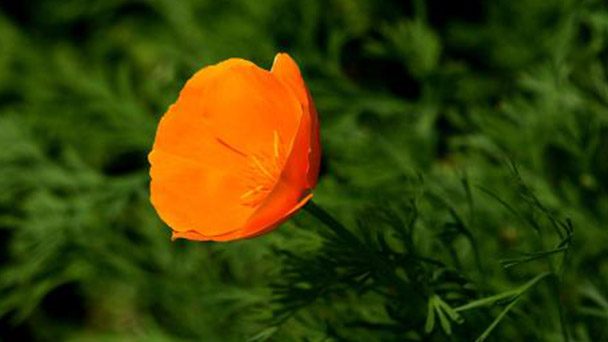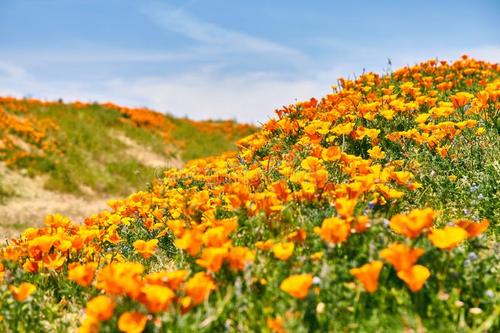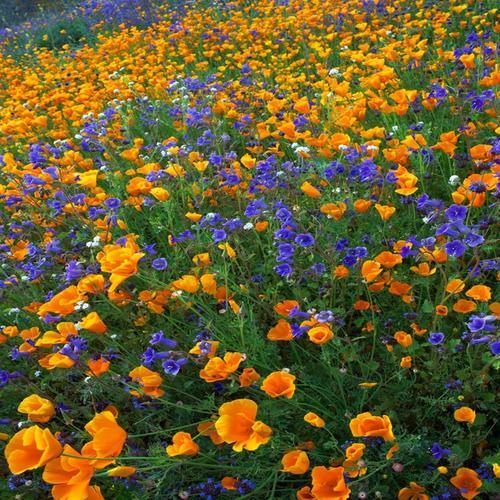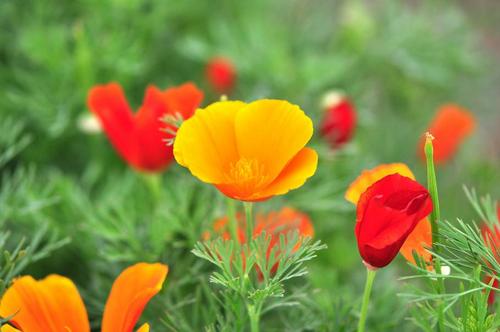California poppy profile
Written by Maggie
Jan 22 2021

California poppy, scientific name Eschscholzia californica, is a perennial herb, often cultivated for a year or two. California poppy has strong cold resistance, like cold and dry climate, can not resist hot and humid, hot summer in a semi-dormant state, often die, and then germination after autumn. California poppy is originally in California, USA.
California Poppy stems and leaves are bright green and gray in color, making it a good source for ribbons, trails, and potted plants. It can also be used in lawns.
California Poppy picture

California poppy characteristics
California Poppy is a perennial, glabrous, bluish-gray plant.
California poppy stem is erect, 30-60 cm high, clearly with longitudinal ribbed, branching many, open, dichaform. Basal leaves are several, 10~30 cm long, petiole long, leaf grayish green, many back to three pinnately fine lobes, lobes variable shape, linear acute, oblong acute or blunt, spatulate oblong, terminal 3 lobes, middle lobes mostly wider and shorter; Cauline leaves the same as basal leaves, but smaller and shortly stipitate.
Leaves are alternate, many back to three out of pinnate division, split linear or elliptic, the whole blade has a long stalk. Flowers are solitary branches apical, ca. 5-7 cm in diameter, long pedicels.
Receptacle protruding, sepals 2, joined into a pointy long helmet, with the expansion of the petals fall off; California poppy has 4 petals, easy to fall off, cross opposite, fan-shaped, margin fine undulate, bright yellow, the base of deep orange yellow, shiny. California poppy cultivated varieties are orange yellow, golden yellow, orange red, light purple red, flesh color, milky white. Petals are often wrinkled, and there are double varieties.
Flowers are solitary on apical stems and branches; Pedicels are 5 -- 15 cm long, receptacles concave, funnel-shaped or sub tubular, 3 -- 4 mm long, cup-shaped after flowering, margin undulate reflexed; California poppy calyx is ovate-bead, ca. 1 cm long, tip short paniculate, sepals 2, glabrescent; California poppy has 4 petals, triangular-flanellate, 2.5 -- 3 cm long, yellow, with orange-yellow spots at base; California poppy has many stamens, about 40 more, filaments filiform, base broadened, about 3 mm long, anthers strip, 5~6 mm long, orange yellow; California poppy ovary is long and narrow, style short, stigma 4, subulate linear, unequal in length.
Capsule narrow cylindrical, 5-8 cm long, detached from receptacle, 2 petals descending from base upward, with many seeds. The fruit is an angulate capsule, slender 7 to 10 cm, shaped like a rape pod. Seeds are globose or slightly elliptic. The flowers of the same genus as this species are clustered California poppy and curved leaf California poppy.
California poppy seeds are spherical, 1-1.5 mm in diameter, with distinct reticulates.
Flowering period from April to August, fruiting period from June to September.
California poppy growing environment
California poppy grows in grasslands and open areas from 0 to 2000 meters above sea level.
California poppy likes cold and dry climate, not easy to hot and humid, should be loose and fertile, well drained, deep upper sandy loam, but also poor soil resistance.
The distribution of California poppy
California poppy is originally in California, USA. It is widely introduced in China as a garden ornamental plant.

California poppy propagation methods
Seed propagation of California poppy
With sowing method propagation of California poppy, winter soil does not freeze the region line autumn sowing. In northern areas, seedlings are raised indoors in early spring and emerge in about 7 days at 15~20℃. In the true leaves to develop in time before the seedling on the pot, no frost, off the pot with soil planting (do not hurt the root, otherwise it is not easy to restore growth.Even death); You can also open the ground before it freezes. With wind barrier protection, the seedlings were unearthed the next year. The seedling stage of California poppy should be supplied with sufficient water and nutrients.To make it grow strong.
Cutting propagation of California poppy
California Poppy cutting substrate is used for cutting nutrient soil or river sand, clay clay and other materials. Family cuttings are limited to conditions are difficult to get the ideal cuttings substrate, it is recommended to use the site has been prepared and disinfected cuttings substrate; Medium-coarse river sand is fine, but rinse with clean water several times before use. Sea sand and saline areas of river sand are not used, they are not suitable for the growth of flowers and plants.
Growing method for California Poppy
(1)California poppy root is fleshy, like monotonous, afraid of waterlogging. In the rainy season, the ground should pay attention to timely drainage, potted plants should be appropriate watering, dry should not be wet, to avoid root neck black erosion.
(2) Because California poppy is a kind of plant with long taproots, it is not resistant to transplantation, it is appropriate to direct seeding seeds in pots.
(3) California poppy sown in spring and flower in summer, but usually grow and flower less well than those sown in autumn. Therefore, sowing should be carried out in August to September, and the suitable temperature for germination is 15-20 ℃. If the germination is not neat, more dense seedlings, appropriate thinning. Planting spacing 20-30 cm, planting to high dry, drainage is better. In California poppy growing season we should pay attention to soil weeding, open winter should take cold prevention measures.
(4) After the skin turns yellow, the fruit of California poppy should be harvested in time in the early morning, otherwise the capsule will crack automatically, leading to seed scattering.
The main value of California Poppy
California Poppy has bright yellow flowers with funnel-shaped or nearly tubular petals. In the domestic often most potted ornamental. California poppy can also be planted.
The sedative and antianxiety effects of California Poppy extract may be related to the activation of benzodiazepine-like receptors, but unlike this class of drugs, the extract has no anticonvulsant or muscle relaxation effects, and its analgesic effect is peripheral rather than central.
California Poppy flower language
Promise me you won't turn me down.

Latest Updated
- Benefits of Bugleweed - 7 Science-backed Health Benefits
- Bugleweed Dangers & Side Effects - Is It Poisonous?
- How to Plant Evergreen Trees - What You Should Know
- When to Plant Evergreens - Grow Guide for Evergreen Trees
- 12 Wonderful Evergreen Shrubs for Your Garden
- 12 Popular Evergreen Plants with Pictures for Beginners
- When And How To Prune A Lilac Bush Like a Pro
- How to Grow & Care for Lilac Vine (Hardenbergia Violacea)
- Japanese Lilac Tree (Syringa Reticulata) Care & Propagation Guide
- Shumard Oak Pros and Cons - What to Know
Popular Articles
- Winter maintenance of Antirrhinum Majus
- How to Grow Terminalia Mantaly Tree
- How to Grow and Care for Crossostephium Chinense
- How to grow Antirrhinum Majus in spring
- Peristeria Elata (Dove Orchid) Profile: Info & Care Guide
- Underwatered Snake Plant (Sansevieria Trifasciata) - Signs And How To Fix
- How to Care for Brazilian Jasmine Plant (Mandevilla Sanderi)
- How to Grow & Care for Graptopetalum Purple Delight in Summer
- Rosa Chinensis (China Rose): Plant Growing & Care Tips
- How to Care for Baby Sun Rose (Aptenia Cordifolia)